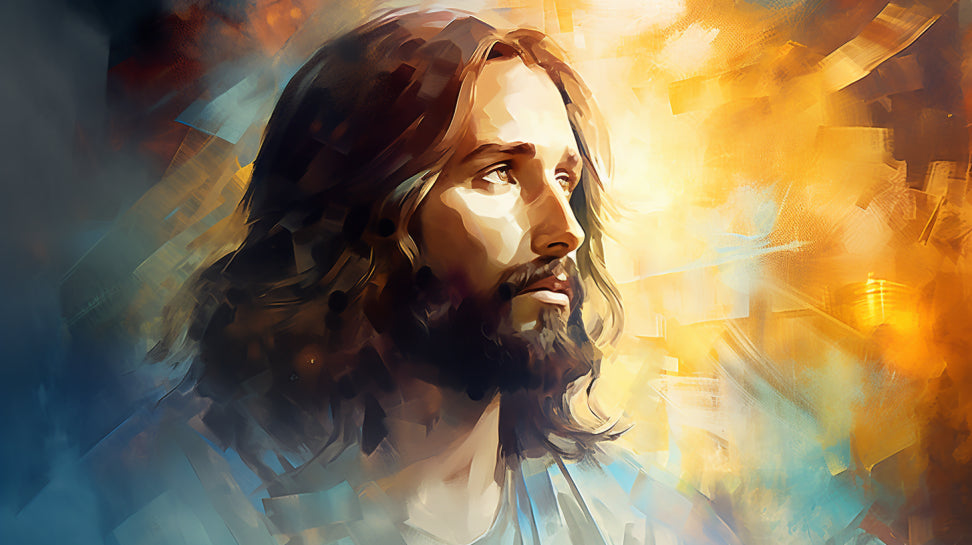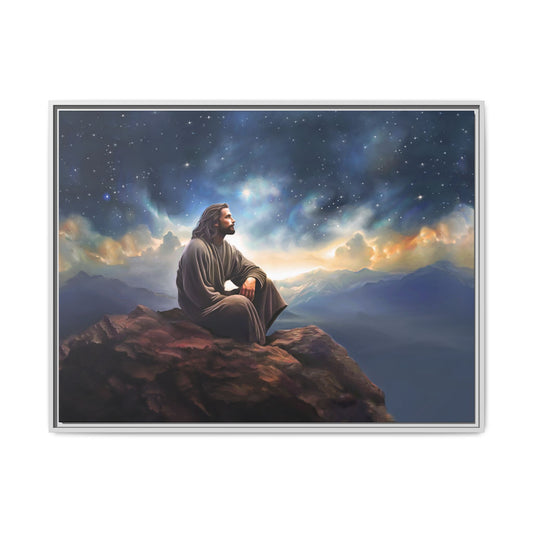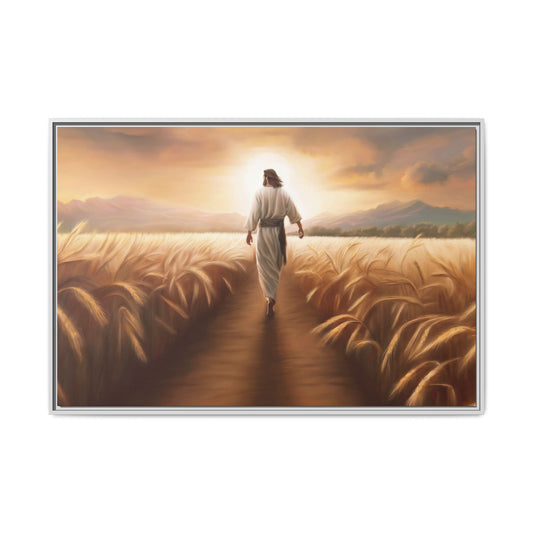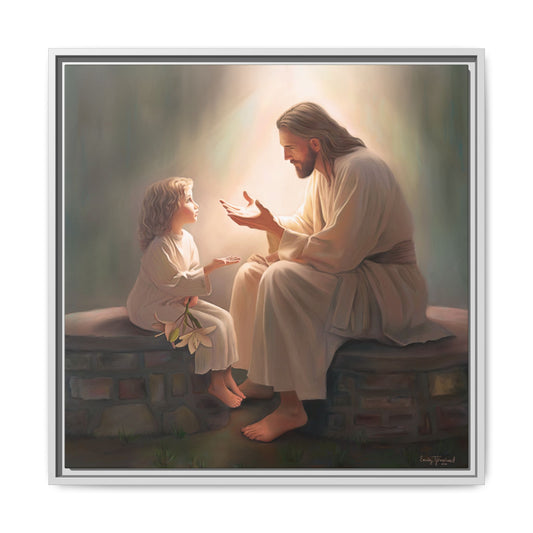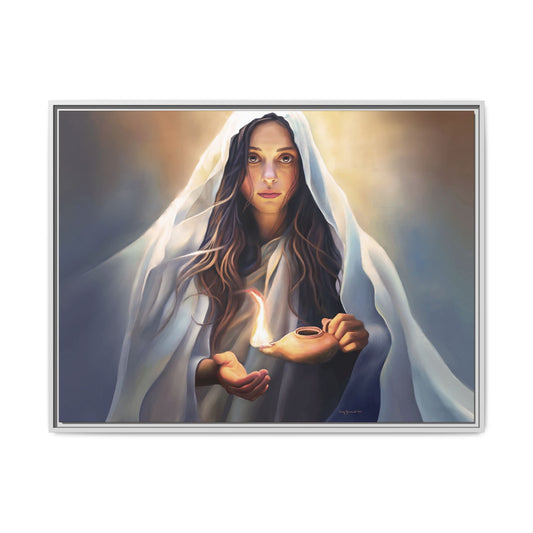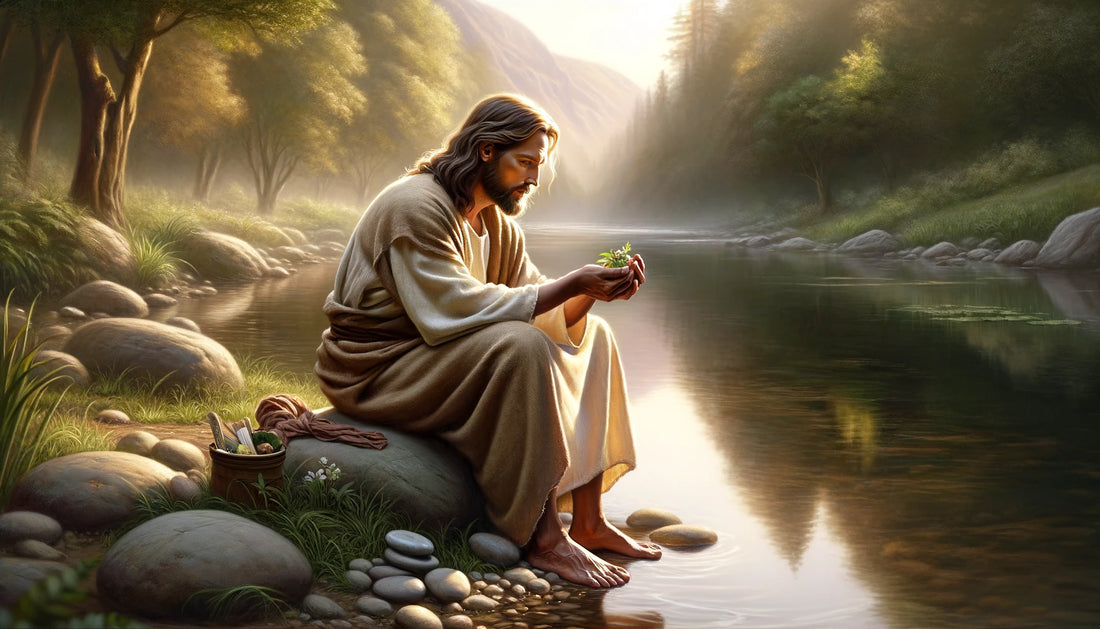
Some of My Favorite Jesus Renderings
Share
As we stand before the tapestry of time, woven with countless interpretations of Jesus, we've come to appreciate the nuanced threads that make up the image of a figure so central to our culture and spirituality. We've seen how each artist's hand, guided by their unique vision and context, has contributed to a mosaic that resonates with a diversity of believers and admirers. These renderings, some steeped in tradition and others breaking boldly into uncharted territory, invite us to consider not just the face of Jesus, but the manifold ways in which his message has been visualized and internalized through the ages. We're eager to share with you the pieces that have not only caught our eye, but have also stirred within us a profound reflection on the intersection of faith and art. As we contemplate these favorite depictions, we hope to open a space where we can explore together the deeper implications they hold for our collective understanding of the sacred.
Key Takeaways
- Dutch artist Bas Uterwijk used artificial intelligence to create a realistic human face of Jesus by feeding the AI program with various artistic renditions of people who lived before the era of photography.
- The AI program combined and found commonalities among the artistic renditions and icons to generate the image of Jesus, which is considered plausible and captures the essence of the iconic figure.
- The influences on the AI-generated image of Jesus are a combination of various artistic renditions and icons, with the icon Christ Pantocrator of St. Catherine's Monastery at Sinai speculated to be a main influence.
- The AI-generated image of Jesus raises questions about whether it will become the mental image of Jesus for our generation, and opinions vary on whether it should replace traditional artistic renditions and icons.
Some of My Favorite Jesus Renderings
Throughout history, we've cherished various portrayals of Jesus, each offering a unique glimpse into how different cultures envision this central figure of Christianity. These images aren't just artistic expressions; they're deeply intertwined with faith and how we perceive the divine. Discussing our favorite renderings of Jesus helps us explore the significance and impact of these portraits on religious thought and cultural identity.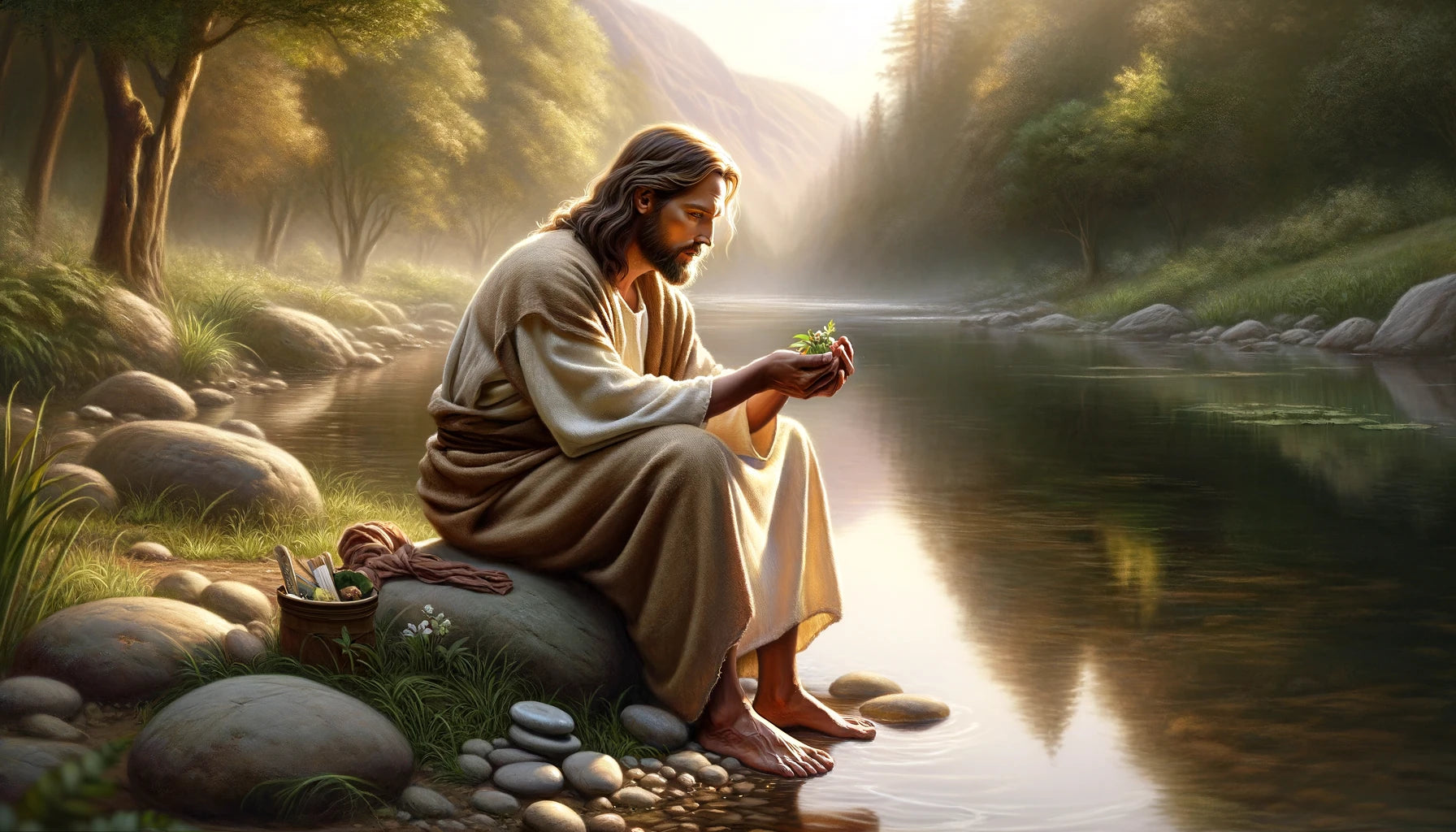
Brief explanation of the importance of Jesus Portraits
Why do portraits of Jesus hold such enduring significance in our collective consciousness? These Jesus renderings serve as a bridge between the divine and the earthly, reminding us of our call to serve others. Each artist rendering of Jesus is more than a mere depiction; it's a visual sermon, a silent yet powerful tool in Christian iconography that inspires compassion, love, and humility. Through the centuries, these images have transcended cultural and linguistic barriers, speaking to the hearts of countless individuals. They encourage us to embody the values Jesus represented. Whether it's a traditional icon or a contemporary piece, a Jesus rendering carries a message of hope and service, continually guiding us toward a life of altruistic action.Jesus Portrait related topics
Certain renderings of Jesus can resonate deeply with our spiritual sensibilities and aesthetic preferences. As we explore Jesus-related topics, we're moved by the devotion and creativity that artists have poured into their representations of Christ. Here are three aspects that deepen our connection:- Historical Accuracy: Artists research cultural and historical contexts to depict Jesus in a manner true to his time.
- Spiritual Reflection: Each portrait of Jesus invites us to reflect on his teachings and serve others with humility and love.
- Artistic Interpretation: The diversity of artistic styles honors the many faces of Christ as seen through the eyes of believers around the world.

Understanding Jesus Portraits
We've seen a multitude of Jesus portraits, each with its own historical significance and purpose within Christian art. These depictions vary widely, offering different interpretations and insights into one of history's most iconic figures. As we consider these portrayals, we'll explore how they've shaped our collective understanding of Jesus through the ages.Definition and purpose of Jesus Portraits
Jesus portraits, ranging from classical artworks to modern digital renditions, serve to visualize the central figure of Christianity, offering believers a tangible connection to the person they worship and follow. We find in these depictions more than just art; they're a call to bring Jesus Christ's teachings into our daily lives, to shine His light in our actions, and to foster a sense of family among all. Here are three deeper meanings these portraits convey:- Inspiration: They remind us to live by Jesus' example of love and sacrifice.
- Guidance: Portraits of Jesus act as visual sermons, guiding us toward a path of righteousness.
- Unity: They symbolize our shared faith, uniting us as a family under His light.
Historical significance of Jesus Portraits in Christian art
Portraits of Jesus throughout history haven't only shaped Christian iconography but also played a crucial role in the cultural and religious identity of countless believers. When we gather in church or come together during Christmas, our favorite Jesus rendering serves as a focal point, reminding us of the values we strive to embody—compassion, love, and service to others. These images, infused with historical significance, connect us to a tradition that transcends time and space. They're not just works of art; they're visual sermons, inspiring us to walk in the footsteps of Jesus. Every brushstroke carries a message of hope and salvation, making these portraits a cornerstone of our faith and community.
Different portrayals and interpretations of Jesus in art throughout history
Throughout history, artists have depicted Christ with a diverse array of visages and attributes, reflecting the cultural and theological nuances of their times. These portrayals have been more than mere art; they've served as a bridge connecting communities of believers to the divine. As we explore various interpretations of Jesus, we find a shared desire to bring his teachings and the essence of godliness into our lives. Here's what these depictions can teach us:- Cultural Reflections: Art mirrors the society in which it's created, including perceptions of the sacred. Jesus' portrayal adapts to resonate with the local populace, whether in a European cathedral or an African temple.
- Theological Statements: Each image embodies theological beliefs, often emphasizing attributes such as Jesus' divinity, his role as a healer, or his kinship with the saints.
- Evolution of Worship: Changing artistic styles reflect evolving practices of worship and highlight how our relationship with God adapts over time.
The Power of Visual Representation
We've seen how portraits of Jesus can evoke deep worship and reverence among believers, shaping their spiritual experience. Through these images, many have shared how their connection to faith has been profoundly enriched. Let's explore personal stories and the emotional resonance these visual representations hold for individuals in their journey of faith.
How Jesus Portraits inspire worship and reverence
In the realm of spirituality, visual representations of Jesus play a pivotal role in inspiring worship and fostering a sense of reverence among believers. We see this influence vividly within the Church of Jesus Christ of Latter-day Saints, where portraits of Jesus enhance the spiritual ambiance in homes, meetinghouses, and temples. These images serve as powerful visual reminders of His teachings and His love, inspiring us to serve others with a Christ-like heart. Here's how these portraits deepen our worship experience:- Encouraging Imitation: We're constantly reminded to emulate Jesus' compassion and selflessness.
- Fostering Connection: Visuals bridge the gap between the divine and us, making His presence felt.
- Enhancing Devotion: Artistic renderings of Jesus often become focal points during prayer and meditation, aiding in deeper spiritual reflection.
Discussion on the emotional and spiritual impact of Jesus Portraits on believers
Portraits of Jesus often evoke profound emotional and spiritual reactions in believers, serving as a catalyst for deeper faith and connection. When we, as latter-day saints, gather in the church Jesus Christ established, these images bolster our resolve to serve others. They remind us of His life and teachings, stirring our hearts and nurturing our spirits. The emotional and spiritual impact of these renderings can't be overstated; they serve as silent yet potent reminders of His enduring love and sacrifice. As we gaze upon these depictions, whether in solitude or communal worship, we're often moved to reflect on His extraordinary example and to emulate His boundless compassion in our daily lives.
Personal anecdotes or testimonials from individuals whose faith has been deepened through Jesus Portraits
Building on the emotional resonance of Jesus' portraits, many believers share poignant stories of how these images have anchored their faith more deeply. We've encountered countless individuals who've found solace and inspiration in the visual representation of our Lord. Here are three ways these portraits have impacted lives:- A young man felt called to serve others after meditating on a portrait of Jesus washing the disciples' feet, reminding him of the president role of servanthood in the kingdom of God.
- A woman battling illness found strength in an image of Jesus' compassionate gaze, deepening her trust in His sovereign care.
- A group of volunteers were moved to start a charity when a mural of Jesus feeding the multitude sparked a collective desire to address hunger in their community.
Evolving Interpretations in Modern Art
As we explore modern artists' interpretations of Jesus, we notice a bold departure from traditional portraits to more unconventional ones. We're intrigued by how societal and cultural shifts shape these new portrayals, offering fresh perspectives on an ancient figure. It's fascinating to compare these contemporary visions of Jesus with the classic images that have dominated for centuries.Examination of contemporary artists' renderings of Jesus
Contemporary artists are redefining the visual narrative of Jesus, introducing a diverse spectrum of interpretations that resonate with modern sensibilities. As we explore these evolving depictions, we're drawn into a deeper conversation about how art can serve as a bridge between historical context and contemporary relevance. Here's what we're seeing:- Inclusivity: Artists are crafting images of Jesus that reflect a broader range of ethnicities and cultures, inviting more people to see themselves in the Christian narrative.
- Social Commentary: Some renditions comment on current social issues, challenging us to see Jesus as a figure deeply connected to justice and compassion.
- Personal Connection: Contemporary renderings often emphasize a personal, relatable Jesus, encouraging a more intimate and individual relationship with the divine.

Discussion on the influence of cultural and societal changes on the portrayal of Jesus in art
Reflecting on the diverse and inclusive images of Jesus offered by contemporary artists, we now consider how cultural and societal shifts have further shaped these portrayals in modern art. As our society becomes increasingly globalized and interconnected, the image of Jesus evolves to reflect a broader spectrum of humanity. We've seen artists step away from traditional Western depictions, embracing a Jesus who resembles the people of the Middle East, where He lived. This commitment to historical and cultural accuracy honors the roots of Christianity and resonates with our dedication to authenticity in serving others. Through art, we're invited to see Jesus not as a distant figure, but as someone who's deeply relevant to every culture and community.Comparison and contrast of traditional Jesus Portraits and unconventional interpretations
How do traditional portraits of Jesus contrast with modern, unconventional interpretations in the evolving landscape of art? We've noticed that the classical depictions often feature a more ethereal, serene Jesus with common attributes like long hair and a halo. In contrast, modern interpretations aren't afraid to humanize Jesus, presenting him in ways that resonate with today's diverse and complex society. Here's what we find meaningful:- Traditional art captures a divine, almost unapproachable Jesus, while modern art brings him closer to our human experience.
- The shift from idealized to realistic reflects our desire to relate to Jesus personally, breaking down barriers of time and culture.
- This evolution challenges us to serve others by seeing the sacred in the everyday, embracing a Jesus who walks among us.

Jesus Portraits and Religious Traditions
We've observed that different Christian traditions hold varied perspectives on the portrayal of Jesus, reflecting their unique theological emphases and cultural contexts. In exploring how Jesus portraits resonate across denominations, we see a spectrum from the rich iconography of Eastern Orthodoxy to the more subdued representations in Protestantism. Notably, The Church of Jesus Christ of Latter-day Saints integrates Jesus portraits into their faith practices, underscoring their significance in religious life and education.Various religious traditions' perspectives on Jesus Portraits
The depiction of Jesus varies significantly across different religious traditions, each bringing its own cultural and theological nuances to these portraits. As we explore these diverse views, we uncover a rich tapestry of imagery that serves as a reminder of our collective mission to serve and love one another. Here are some key perspectives:- Eastern Orthodox Iconography: Emphasizes the divine nature of Jesus, often featuring a halo and stylized features to inspire reverence and contemplation.
- Western Christian Art: Typically presents Jesus in a more humanized form, focusing on relatability and the incarnation, to foster a personal connection with the divine.
- Non-Christian Artistic Interpretations: Offers unique cultural representations that encourage dialogue and understanding across different faiths and beliefs.
The role of Jesus Portraits in different Christian denominations
Portraits of Jesus hold a unique place in the worship and identity of various Christian denominations, shaping the faithful's perceptions and devotional practices. In Catholicism, for instance, we often see a rich tradition of icons and religious imagery where the faithful venerate images as part of their devotional life. They serve as focal points for prayer and reflection, embodying the virtues and life of Christ. Protestant communities, however, may approach Jesus' portraits differently. Many prioritize the Word and may use images more as teaching tools rather than objects of veneration. We find that the role these portraits play can vary greatly—from inspiring artistry in Orthodox churches to symbolizing teachings in evangelical spaces. They're integral in helping us to serve and honor His message.
The Church of Jesus Christ of Latter-day Saints' views on Jesus Portraits and their significance within the faith
In exploring the Church of Jesus Christ of Latter-day Saints, we find that portraits of Jesus carry profound significance, shaping members' faith and worship practices. These images serve as visual reminders of the Savior, reinforcing core tenets of the faith. Here's what they mean to us:- Icons of Devotion: Portraits of Jesus foster a personal connection, encouraging reflection on His life and teachings.
- Aids in Worship: They enhance our worship environments, focusing our thoughts on Christ during services.
- Tools for Outreach: Artwork depicting Jesus aids in missionary efforts, offering a relatable image to those we're serving.
The Role of Jesus Portraits in Spiritual Practices
We've seen how portraits of Jesus serve as focal points for personal devotion, often guiding believers in prayer and reflection. In religious ceremonies, these images become anchors for communal rituals, embodying the sacred presence they celebrate. Moreover, they foster a sense of unity in worship, helping to cultivate shared spiritual experiences within faith communities.
How Jesus Portraits are used in personal devotion and prayer
Many believers find that gazing upon portraits of Jesus can deeply enhance their personal devotion and prayer experiences. These images serve as a focal point, reminding us of His presence and guiding us in our spiritual journey. Here's how these sacred depictions can deepen our faith and service:- Fostering Connection: Portraits of Jesus serve as visual bridges, connecting us to the divine and fostering a personal relationship with Him.
- Aiding Contemplation: By focusing on His image, we can contemplate His teachings and emulate His love and compassion in our service to others.
- Enhancing Meditation: Jesus' image can be a tool in meditation, helping to center our thoughts on His peace and wisdom as we seek guidance in prayer.
Discussion on the use of Jesus Portraits in religious ceremonies and rituals
While personal devotion often incorporates portraits of Jesus as a means to deepen faith, these sacred images also play a crucial role in community worship and religious ceremonies. We find that these depictions of Jesus serve not only as focal points for contemplation but also as tangible connections to the divine for many believers. In times of collective prayer, baptisms, or the celebration of Communion, the presence of Jesus' image invites us to reflect on His teachings and sacrifice. It's about creating a space where we can gather and serve one another in His name. Through these portraits, we're reminded of who we're called to emulate, strengthening our resolve to live out the love and compassion Jesus exemplified.
The impact of Jesus Portraits in promoting community worship and shared spiritual experiences
Portraits of Jesus not only adorn the walls of churches and homes but also deeply enrich our communal worship and spiritual connections. As we gather to serve and uplift each other, these sacred images serve as visual focal points that encourage unity among us, as they remind us of the shared values and teachings of Christ. They also inspire a collective sense of purpose, guiding us in our mission to serve others with compassion and love. Additionally, these portraits facilitate a deeper emotional and spiritual resonance, allowing us to experience the presence of the divine collectively. In every look upon these portraits, we find a mirror of our own devotion and a window into the soul of our community.The Responsibility of Artists
As artists, we bear a profound responsibility to depict Jesus with both reverence and historical fidelity. We must consider the ethical implications of our interpretations, ensuring they honor the message and essence of His teachings. Through our artwork, we have the opportunity to communicate the profound narratives of Jesus in ways that resonate with and inspire contemporary audiences.Importance of portraying Jesus with respect and accuracy
We must acknowledge the profound responsibility artists bear when depicting Jesus, ensuring their work conveys both respect and historical accuracy. As creators, we're tasked with honoring the image of a figure central to the faith of millions. Our representations can shape perceptions and deepen understanding, so we're committed to approaching this task with the utmost care and consideration. Here's what we uphold in our artistic endeavors:- Historical Context: We strive to reflect the cultural and historical setting of Jesus's life in our artwork.
- Respectful Representation: Our depictions aim to honor the sacredness and dignity of Jesus's image.
-
Educational Value: We ensure our art serves as a tool for learning and reflection, enriching the spiritual journey of others.

Discussion on ethical considerations for artists when creating Jesus Portraits
Grasping the paintbrush of responsibility, we must navigate the ethical terrain with sensitivity when depicting Jesus, ensuring our work reflects both reverence and historical integrity. We're tasked with creating portraits that not only honor the sacredness of His image but also consider the cultural and historical context of His life. It's vital that we engage with this task humbly, aiming to serve those who seek a visual connection to their faith through our art. We recognize that our interpretations carry weight and can influence perceptions. Therefore, we're committed to researching diligently and approaching our artistic expressions of Jesus with the utmost care, striving to balance artistic freedom with the responsibility we hold in representing a figure so central to many.How artists can convey the message of Jesus through their artwork
While mindful of the ethical considerations in depicting Jesus, artists also bear the responsibility of embodying His teachings and message within their creations. We strive to ensure that our artwork resonates with those who seek to serve others, by capturing the essence of His compassion, humility, and love. Our goal is to convey a deeper meaning that inspires and uplifts the spirit. Here's how we can achieve this:- Portraying stories of kindness and sacrifice that echo Jesus' life and works.
- Emphasizing universal themes of love and forgiveness that transcend cultural boundaries.
- Incorporating symbolism that reflects the profound impact of His teachings on humanity.

Conclusion
We've explored a diverse array of Jesus portraits and the innovative AI interpretations that are shaping our visual landscape. Let's embrace these worshipful expressions as they enable us to connect more deeply with our faith. In closing, it's clear that the enduring power of Jesus's image continues to inspire and strengthen spiritual bonds across generations.Recap of the article's main points
In this article, we've explored the innovative process behind Bas Uterwijk's AI-generated image of Jesus, which melds historical artistry with modern technology. We visited how this approach could potentially reshape our visual perception of historical figures like Jesus, who's been depicted in countless ways throughout history. Here's what we've learned:- AI Technology as an Artistic Tool: Uterwijk's work shows us how AI can be used to synthesize historical data into new, plausible visual representations.
- Historical Accuracy: The AI-rendered image challenges us to consider the historical authenticity of our cherished icons.
- Cultural Impact: The depiction has the potential to influence how future generations visualize one of the most significant figures in human history.

Encouragement for readers to embrace the worshipful expressions of a Jesus Portrait
As we reflect on the diverse representations of Jesus, let's embrace the potential for these portraits to deepen our worship and connection with the divine. Each rendering, whether it stems from traditional artistry or innovative AI technology, offers us a unique avenue to engage with and serve the image of Jesus in our midst. Let's encourage one another to find solace, inspiration, and a sense of kinship in these varied depictions.Final thoughts on the enduring power of Jesus Portraits in inspiring faith and deepening spiritual connections
Portraits of Jesus, whether painted by the hands of ancient artists or crafted through modern AI, continue to inspire and deepen our spiritual connections. These images serve not just as a reflection of history or theology, but as a personal bridge to the divine for many of us. As we close our exploration of Jesus' portraiture, let's consider their enduring power:- Invitation for Reflection: They provoke thought and contemplation, encouraging us to look beyond the surface.
- Cultural Resonance: These portraits transcend time, speaking to us in the language of our own era.
- Guidance in Service: They remind us of the virtues Jesus embodied, inspiring us to serve others with compassion and humility.
